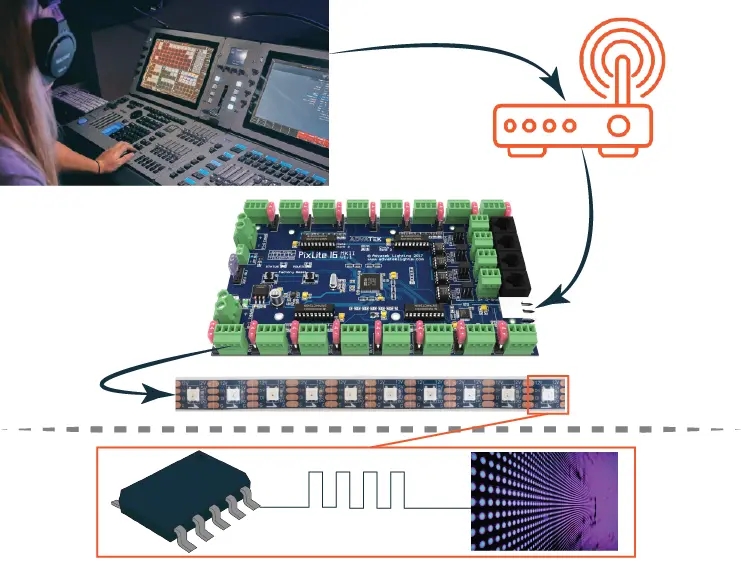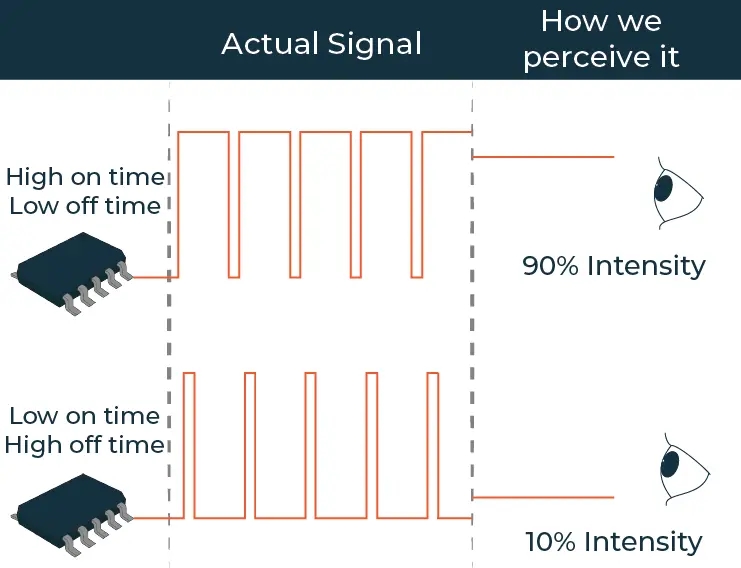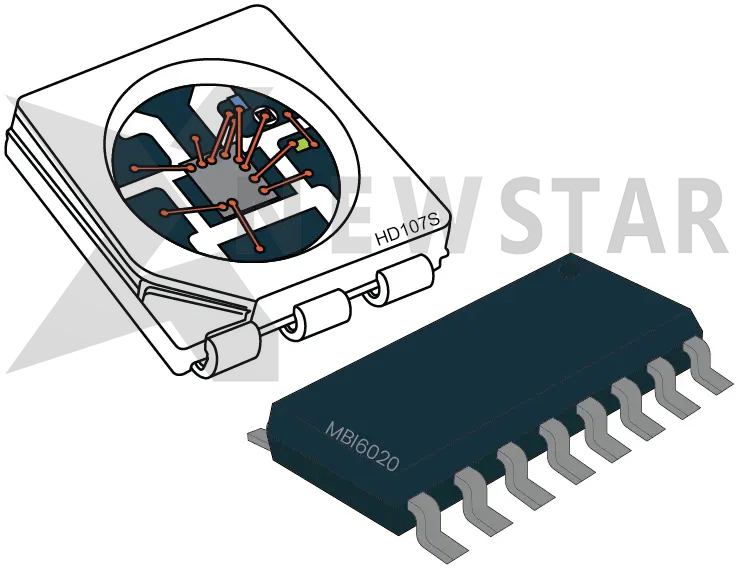Refresh Rate and PWM Rate of Pixel LEDs
Release time:2021/4/22 14:57:48
Refresh Rate and PWM Rate of Pixel LEDs
Selecting the right kind of pixel lights can be hard work, especially when you’re looking at specifications that you might not fully understand. Refresh rates are different to PWM rates, and both play an important role in your design. Talk to us to learn more.
THE TWO RATES IN CONTEXT
Your pixel light system can be broken down into many stages of data transmission. All stages from the sending software through to the pixel chips themselves can affect the overall refresh rate. The PWM rate is only affected by the output of the IC chip used in the pixel LEDs.
To put this in the context of a pixel system, everything before the dotted line in this image can affect Refresh Rate; everything after the dotted line will affect PWM Rate.

SENDING SOFTWARE FRAME RATE
Generally, software that is used to generate and send data to yourPixLite LED controller will group this data into frames. Each frame consists of a specific instruction for each pixel that is configured – telling each one what color and how bright it should be. There may be many “universes” of data in each frame. Whilst it can be very fast to transmit the frame over the network, it normally takes more time for the software to generate the pattern / lighting data compared to how long it takes to send. The time it takes the sending software to generate and send one frame will have an impact on the maximum frame rate the system can achieve.
Some lighting software will have an option for you to specify the frame rate you wish to use, usually between 20 and 100 frames per second (FPS). If there is no option for this, the software may set its own frame rate based on its performance, or it may use a variable output rate.
The maximum frame rate of the sending software may be dependent on configuration and efficiency of the software you are using, as well as the hardware you are running it on.
OVERALL REFRESH RATE
After the data is transmitted by the sending software, it is processed by the network, then the PixLite LED controller, and finally the pixel lights. Each one of these stages will take some time. As these add up, the total amount of time it takes the data to travel from the sending software through to the pixel lights will result in a slight delay. This delay is called latency.
The overall refresh rate of your pixel display will depend primarily on the frame rate of your sending software, as long as the total latency does not prohibit this. For example, if the pixels you are using have a slow data rate which takes a long time for the PixLite to send out, this latency may result in an overall system refresh rate that cannot keep up with the sending software’s frame rate.
A faster refresh rate is better, allowing for quick and dynamic changes to the pixels to create a system that is capable of displaying any effect you could imagine. A low refresh rate might result in content that doesn’t look as smooth as it should. There are many factors that can affect the overall refresh rate – see theRefresh Rate technical note for more information.
WHAT IS A PWM?
When pixel chips use the data that they receive to dim the LED itself, they normally utilise a method of dimming called Pulse Width Modulation (PWM). The LEDs are driven with a waveform that turns them on and off really quickly. The duration of the ‘on’ time and ‘off’ time can be altered by the chip, allowing the LEDs to spend a specific amount of time on, compared to off. A PWM signal is generated for each LED, allowing each color of each pixel to be modified independently.

HOW HUMANS PERCEIVE A PWM
The PWM signal operates at a very high frequency – so high that the human eye cannot perceive these changes. Instead, our eyes see the average of these signals. This means that, if a 50% intensity is required, then the ‘on’ and ‘off’ times should be the same. To increase this perceived intensity, the ‘on’ time simply needs to be increased, and the ‘off’ time decreased.
Another interesting trick that our eyes play on us is that we don’t perceive light linearly. If a pixel light increases in intensity from 0% to 100% at a constant rate, we will see the first increases in intensity as larger changes. This leads to the reason why gamma correction is useful – it alters the curve to which pixels are dimmed, so that we perceive them to dim much more smoothly. Lighting designers should take this into account, as dimming curves should look smooth to an audience.
The rate at which a PWM signal is repeated is called the PWM Rate. Pixel lights with a higher PWM rate can outperform budget-grade lights when camera footage is important, such as shows, light displays, architectural façades and many more.
WHAT DETERMINES THE RATE OF A PWM?
The PWM rate is a fixed rate that is solely dependent on the type of pixels you are using. The IC chips that drive each pixel normally generate a PWM signal at a fixed frequency, regardless of the incoming data. This means that the only factor that affects PWM rate is the design of the pixel lights themselves. Protocols such as MBI6020 and SK9822 offer incredibly high PWM rates, while others are limited to a low PWM rate. Selecting the right pixel is critical for your design.
PixLite LED controllers provide support for most pixel protocols you will find. The team of lighting specialists at Advatek can help you determine what you need.


 English
English Deutsch
Deutsch Español
Español




